|
|
|
Hansen's Northwest Native Plant Database |
|
|
|
Rosa gymnocarpa (Bald-Hip Rose, Little Wild Rose)
|
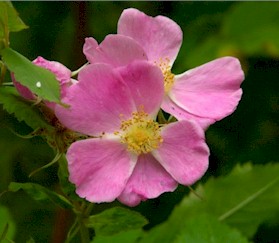 |
||||||||||||||||||||||||||||||
|
This beautiful native rose is slender and delicate. It grows rapidly to 3-5' and is adorned with tiny 1" pink flowers with single petals in attractive clusters. The foliage is fine, even lacy and the branches are bristled rather than thorned. The naked hips are a brilliant red and remain on stems throughout winter. This rose is native to the Pacific Coast in shady, moist locations. It will not, however, tolerate waterlogged soils. It is hardy from USDA zones 7-9. |
|||||||||||||||||||||||||||||||
|
The following article is by Colleen Stuckey, who lives on Vancouver Island, British Columbia, Canada. |
|||||||||||||||||||||||||||||||
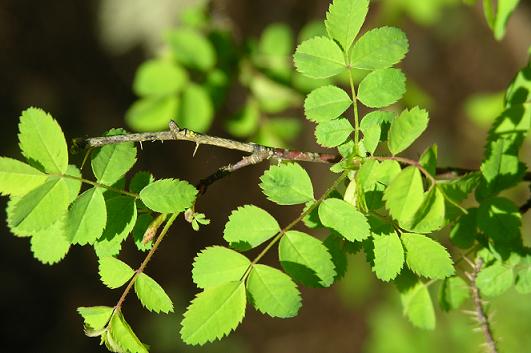 |
Tucked amid the dense understory of the Pacific Coast rainforest, you may chance upon a tiny rose, delicate in every way. The Bald-Hip Rose seeks out a shaded location, reaching upwards towards the filtered light. It is a perfect choice for small, shaded gardens or woodland plantings. The Bald-Hip Rose is an elegant rose, petite and graceful. Yet despite its delicate appearance, the Bald-Hip Rose is extremely hardy, surviving as far as 52° N latitude, from zones 7 - 9. It grows quickly to 3 and does not spread as fully as other wild roses, instead remaining a slender shrub. |
||||||||||||||||||||||||||||||
|
Its
alternate, pinnately compound leaves have five to seven ovate and serrated
leaflets from ½ - 1 long and Ό -½ wide. The small, sweet-smelling
flowers are pink and only 1 wide. Each flower has five petals and five
small sepals which are only a ½ long. Unlike other roses, the sepals
of the Bald-Hip Rose drop off as the fruit develops (hence the name). The
fruits, called hips, of the Bald-Hip Rose are a mere Ό long. Inside
the hips are the seeds, which are covered, in a thick hair that can
irritate the digestive tract if eaten. |
|||||||||||||||||||||||||||||||
|
The Bald-Hip Rose is very distinct from other wild roses. It is the smallest wild rose with the most delicate flowers and hips. It also has many tiny bristles on the stems where other wild roses have sharp, vicious thorns. The sepals of the Bald-Hip Rose do not persist on the hips as they do in other species. The Bald-Hip Rose is further distinct in that it prefers an alkaline soil (pH 6-8) and shady, woodland location from sea level to 5000 elevation. Other wild roses tolerate far more acidic soil and prefer sunnier spots. The Bald-Hip Rose, like all wild roses, spreads by runners. However, because it is such a slender plant, it does not form the dense stands common to other species. The ideal location for a Bald-Hip rose is a moist, not wet, spot with
filtered sunlight. The soil should be alkaline and not overly rich. This
species is moderately tolerant of drought, so will not require a great
deal of water. |
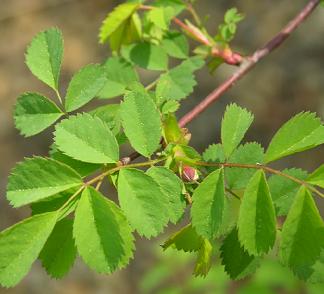 |
||||||||||||||||||||||||||||||
|
Habitat And Range: Bald-Hip roses are generally found in open conifer forests from southern British Columbia to California and east to Montana. They are found in the following distinct geographical regions: the northern Pacific border, the Cascade Mountain Range, the Sierra Mountains, the northern Rocky Mountains and the Columbia Plateau (Fire Effects Information). |
|||||||||||||||||||||||||||||||
|
The Bald-Hip Rose often grows in the path of rainwater runoff and can help to locate seasonal waterways in dry periods Ornamental Value: The Bald-Hip rose is a beautiful plant in a shaded garden. The delicate and inconspicuous nature of the Bald-Hip Rose lends well to combining with brassier plants. The evergreen native Salal (Gaultheria shallon) would serve as a backdrop to accentuate the tiny flowers in summer and remain lush throughout the winter when the Bald-Hip Rose is bare of leaves. Another excellent choice would be Creeping Oregon Grape (Berberis repens), which flowers in May, before the roses. This low-growing plant would highlight the roses in summer, moving to center stage in autumn with its fiery display of color when the Bald-Hip Rose is leafless and barely noticeable. |
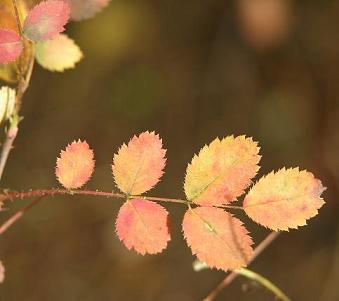 |
||||||||||||||||||||||||||||||
|
Native Plant Gardening/Wildlife Habitat:
The Bald-Hip Rose is a very resilient plant, surviving despite damage
from logging and fire. Because it can survive a forest fire, it serves as
a valuable browse plant for white-tailed and mule deer, especially when
other plants have been killed. While the browsing itself rarely kills the
Bald-Hip, the feet of the larger animals often crush the rhizomes, thereby
injuring the plant. It will
not, however, tolerate extended periods of harsh winter weather (Fire
Effects Information website). |
|||||||||||||||||||||||||||||||
|
Restoration and Mitigation Value: The Bald-Hip Rose is able to grow on very steep slopes. The runners spread rapidly, holding the soil intact and are therefore invaluable in preventing erosion. They are also able to grow in areas with minimal amounts of topsoil and on north-facing sites. Historical / Cultural uses: The leaves and bark of the Bald-Hip rose was toasted and smoked by First Nations people either on its own or mixed with other plants. Wild Tobacco (Nicotania attenuata), which was cultivated by several tribes, was combined with the leaves of Kinnikinnick (Arctostaphylos uva-ursi), Red-Osier Dogwood (Cornus sericea ssp. stolonifera), Pacific Blackberry (Rubus ursinus) and Dwarf Blueberry (Vaccinium caespitosum) or Red Alpine Blueberry (Vaccinium scoparium), the roots and leaves of Mountain Valerian, the leaves and bark of Bald-Hip Rose. The former plants were added to tobacco to improve its taste and make it last longer and smoked in pipes [Turner, p.219]. |
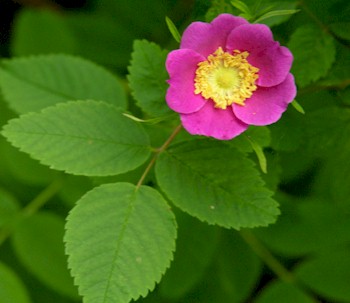 |
||||||||||||||||||||||||||||||
|
Edible and Medicinal Uses: The Bald-Hip Rose is not used as often as a food source as the other wild roses as the hips are so small. The petals, however, are edible and can be used to garnish appetizers or desserts. Trim the bitter white base before using. *Please use caution when preparing or eating any parts of a plant. Identification of the species and knowledge of a plants toxicity are both essential before using any plant species medicinally or otherwise. Please consult with a health professional before attempting to treat any ailment. |
|||||||||||||||||||||||||||||||
|
Propagation Techniques:
Plant Associations: In a natural setting, the Bald-hip Rose is found growing amid Dwarf and Creeping Oregon Grape (Berberis nervosa and Berberis repens), Salal (Gaultheria shallon), Thimbleberry (Rubus parviflora), Ninebark (Physocarpus capitatus), Big Huckleberry (Vaccinium membranaceum) and Oceanspray (Holodiscus discolor) (Fire Effects Information). |
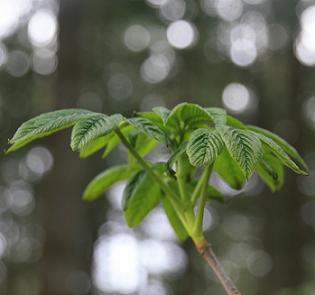 |
||||||||||||||||||||||||||||||
|
For a short comparison of northwest native roses, click here. |
|||||||||||||||||||||||||||||||
|
Photos We Share!
|
|||||||||||||||||||||||||||||||
|
Bibliography:
Klinka, K.; Krajina, V.J.; Ceska, A.; and Scagel, A.M. Indicator Plants of Coastal British Columbia. Vancouver, British Columbia: University of British Columbia Press, 1989 Pettinger, April. Native Plants in the Coastal Garden: A Guide for Gardeners in British Columbia and the Pacific Northwest. Vancouver, British Columbia: Whitecap Books, 1996 Toogood, Alan. Plant Propagation Made Easy. London, England: Dent Co., 1993 Turner, Nancy J. Food Plants of British Columbia Indians. Victoria, BC: British Columbia Provincial Museum, 1978 Vermeulen, Nico. Encyclopedia of Herbs. Vancouver, British Columbia, 1998 Fire Effects Information, USDA, Forest Services, Rocky Mountain Research Station, Fire Sciences Laboratory, Missoula, Montana. http://www.fs.fed.us/database/feis Plants for a Future (September, 2001) http://www.comp.leeds.ac.uk/pfaf United States Department of
Agriculture, Natural Resource Conservation Service (April, 2002)
http://plants.usda.gov Washington State Native Plant Society. 7400 Sand Pt. Way NE, Seattle, WA 98115. (March, 2002) http://www.wnps.org |
|||||||||||||||||||||||||||||||
|